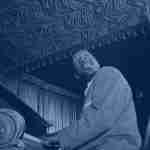If I asked you to name a iii VI ii V in the key of F#, how quickly could you conjure up the answer? If the time it takes you to think through that progression in your mind takes more than a millisecond, chances are you’re going to have a hell of a time playing over it. Common progressions like iii VI ii Vs must be so ingrained into your brain, that you don’t have to think to name them. You just know them. Visualizing these progressions daily will greatly improve your recall of common chord progressions, making it easier to think and play in all keys.
For the following 10 exercises, visualize just the chord symbols. Keep the chord symbol as simple as possible, for instance, do not visualize the “7” in a minor seventh chord or any alterations on dominants. This will help you “see” more quickly in all keys without cluttering the progression in your mind’s eye.
The goal is to clearly see in your mind’s eye a concise picture of the chord symbols for each progression in all keys.
1.) ii V I I
Start with a simple two-five progression, resolving to the tonic for two measure. Do the key of C, then move down in half steps until you’ve visualized the chord symbols in all the keys.
2.) ii V I
Now do a one-measure two-five resolving to the tonic for a bar. It should be easy after exercise #1. Continue through all the keys.
3.) ii V I VI
This exercise is the same as #1, however, now you’ll visualize the VI dominant chord symbol in measure 4, returning to the ii chord in measure 1. Repeat each a key a few times until you’re comfortable with the VI chord moving back to the ii chord. Then move down in half steps until you’ve gone through all twelve keys.
4.) iii VI ii V I
Visualize a three-six-two-five resolving to it’s tonic, for each key.
5.) ii Vs down in whole steps
Visualize the chord symbols of two-fives moving down in whole steps. This is similar to the three-six-two-fives, except instead of resolving, it just keeps going. Start on E- A7, descend in whole steps until you reach E- A7 again, at which point you’ve done six of the keys. Repeat these six a few times, then move up a half step to F- Bb7 and descend in whole steps until you come back to F- Bb7 to do the other six keys.
6.) Cycle of Dominants
Start on G7 and work your way around the cycle until you arrive back at G7.
7.) Cycle of Dominants, two beats a piece
Start on G7 and visualize the chord symbols around the cycle until you come back to G7, but this time each chord lasts two beats instead of four.
8.) Rhythm Changes Progression (First 4 measures)
Because you’ve visualized two-fives and three-six-two-fives, the first 4 measures to rhythm changes should be cake. Start in C, then take the progression through all keys.
9.) Bird Blues Progression
The first 4 measures to a Bird Blues, resolving to the IV chord in measure 5, is very common. It pops up in Confirmation, Blues for Alice, and tons of other tunes. Start in G, then take it through all the keys.
10.) All The Things You Are Progression (First 8 measures)
Chunks of tunes you’re working on make great visualization exercises. Take a piece of a tune and visualize the chord symbols in all keys. You’ll find yourself understanding the chunk of the tune much better than you did before. Here I’ve illustrated the first 8 measures of “All The Things You Are” for you to take through the keys.
Get the roots solid and go from there
As described, the goal is to implant these chord symbols firmly into your mind, making it a cinch to recall common chord progressions in all keys. As you progress, you can always make things more challenging.
You could try visualizing various chord tones over the progressions as described in the later part of Visualization for Jazz Improvisation, or any other exercise you can think of. Be creative, but return periodically to just the chord symbols to ingrain them deeper and deeper into your mind. Now how quickly can you conjure up a iii VI ii V in the key of F#?
And if you want to take your visualization skills to new heights, make sure to check out our Visualization Course!




















